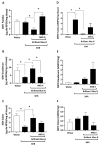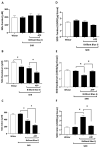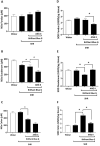P2X7 receptor antagonist improves gastrointestinal disorders in spontaneously hypertensive rats
- PMID: 36856255
- PMCID: PMC9974071
- DOI: 10.1590/1414-431X2023e12569
P2X7 receptor antagonist improves gastrointestinal disorders in spontaneously hypertensive rats
Abstract
The purinergic system participates in the control of blood pressure. Hypertension promotes the occurrence of gastrointestinal disorders such as intestinal inflammation and gastric emptying delay. This study aimed i) to investigate the participation of the P2X7 receptor blocker Brilliant Blue G (BBG) on gastric emptying of solids and changes in oxidative stress in the gastric fundus, duodenum, and colon of spontaneously hypertensive rats (SHR) and ii) to study the putative relationship of this effect with the renin-angiotensin system. Rats were divided into five groups: Control, SHR, SHR+BBG, SHR+BBG+ATP, and SHR+BBG+ANG II. In the gastrointestinal tract, we assessed gastric emptying (GE) and oxidative stress markers (NOx, MPO, GSH, SOD). We observed a decrease in the GE rate (P<0.05) in SHR vs control rats (21.8±2.0% vs 42.8±3.5%). The decrease in GE was returned (P<0.05) to control levels by BBG in SHR rats (21.8±2.0% vs 41.6±3.2%). Co-administration of ATP or ANG II together with BBG bypassed the effect of the P2X7 antagonist on GE in SHR (P<0.05) (21.9±5.0% vs 25.6±3.0% vs 41.6±3.2%). The MPO activity increased (P<0.05) in the gastric fundus of SHR compared to control rats (6.12±2.26 vs 0.077±0.02 UMPO/mg tissue); this effect was prevented (P<0.05) by BBG (0.55±0.15 vs 6.12±2.26 UMPO/mg tissue). Data demonstrated that blockage of P2X7 receptors with BBG can improve the GE delay and oxidative stress biomarkers in SHR animals. This preventive effect of BBG on GE delay was abrogated by ANG II and ATP, thus prompting crosstalk between renin-angiotensin and the purinergic signaling systems underlying this phenomenon.
Figures







References
-
- Mohammed-Ali Z, Carlisle RE, Nademi S, Dickhout JG. Animal models of kidney disease. Animal Models of Study Human Disease. 2017:379–417. doi: 10.1016/B978-0-12-809468-6.00016-4. - DOI
MeSH terms
Substances
LinkOut - more resources
Full Text Sources
Research Materials
Miscellaneous

